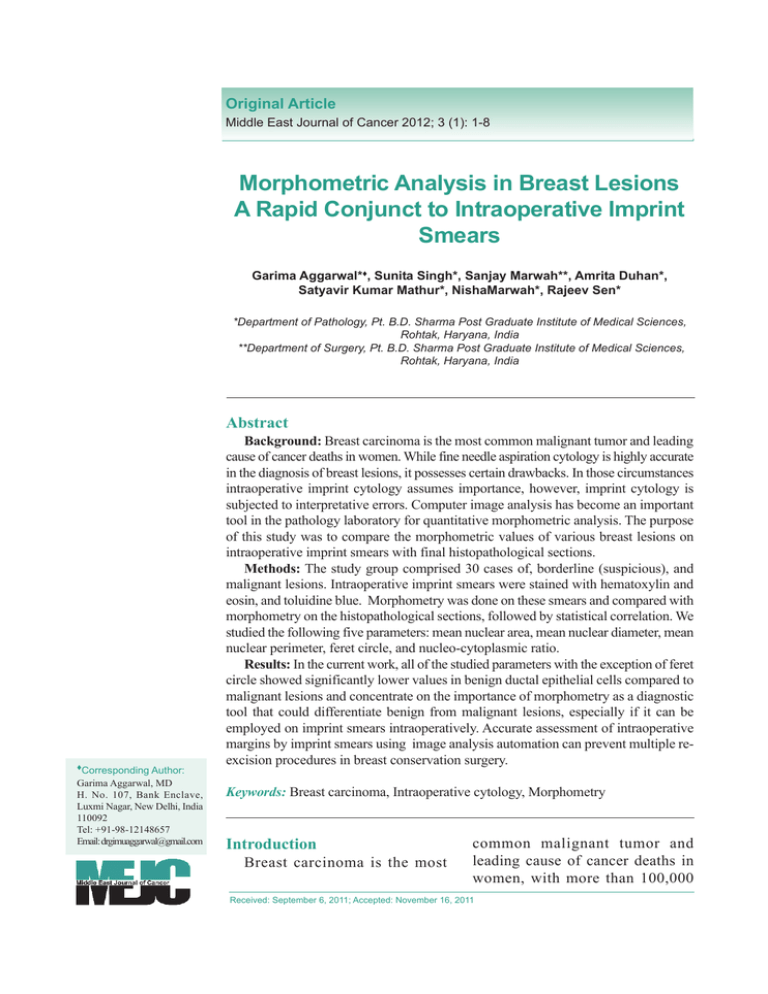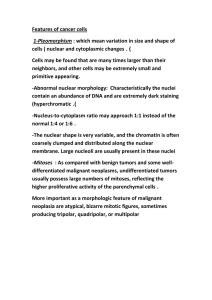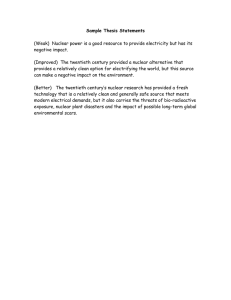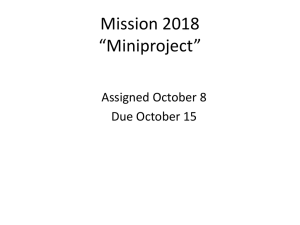Morphometric Analysis in Breast Lesions A Rapid Conjunct to
advertisement

Original Article Middle East Journal of Cancer 2012; 3 (1): 1-8 Morphometric Analysis in Breast Lesions A Rapid Conjunct to Intraoperative Imprint Smears Garima Aggarwal*♦, Sunita Singh*, Sanjay Marwah**, Amrita Duhan*, Satyavir Kumar Mathur*, NishaMarwah*, Rajeev Sen* *Department of Pathology, Pt. B.D. Sharma Post Graduate Institute of Medical Sciences, Rohtak, Haryana, India **Department of Surgery, Pt. B.D. Sharma Post Graduate Institute of Medical Sciences, Rohtak, Haryana, India Abstract ♦Corresponding Author: Garima Aggarwal, MD H. No. 107, Bank Enclave, Luxmi Nagar, New Delhi, India 110092 Tel: +91-98-12148657 Email: drgimuaggarwal@gmail.com Background: Breast carcinoma is the most common malignant tumor and leading cause of cancer deaths in women. While fine needle aspiration cytology is highly accurate in the diagnosis of breast lesions, it possesses certain drawbacks. In those circumstances intraoperative imprint cytology assumes importance, however, imprint cytology is subjected to interpretative errors. Computer image analysis has become an important tool in the pathology laboratory for quantitative morphometric analysis. The purpose of this study was to compare the morphometric values of various breast lesions on intraoperative imprint smears with final histopathological sections. Methods: The study group comprised 30 cases of, borderline (suspicious), and malignant lesions. Intraoperative imprint smears were stained with hematoxylin and eosin, and toluidine blue. Morphometry was done on these smears and compared with morphometry on the histopathological sections, followed by statistical correlation. We studied the following five parameters: mean nuclear area, mean nuclear diameter, mean nuclear perimeter, feret circle, and nucleo-cytoplasmic ratio. Results: In the current work, all of the studied parameters with the exception of feret circle showed significantly lower values in benign ductal epithelial cells compared to malignant lesions and concentrate on the importance of morphometry as a diagnostic tool that could differentiate benign from malignant lesions, especially if it can be employed on imprint smears intraoperatively. Accurate assessment of intraoperative margins by imprint smears using image analysis automation can prevent multiple reexcision procedures in breast conservation surgery. Keywords: Breast carcinoma, Intraoperative cytology, Morphometry Introduction Breast carcinoma is the most common malignant tumor and leading cause of cancer deaths in women, with more than 100,000 Received: September 6, 2011; Accepted: November 16, 2011 Garima Aggarwal et al. cases occurring worldwide annually.1 As baby boomers continue to age, the absolute number of women with breast cancer is expected to increase by about a third over the next 20 years, due to the aging of this population.2 Although fine needle aspiration cytology (FNAC) is highly accurate in the diagnosis of breast lesions it possesses certain drawbacks. In such conditions intraoperative imprint cytology assumes importance to prevent the need for a two-stage procedure in the surgical management of breast cancer.3 Intraoperative imprint cytology is a simple, rapid, and inexpensive diagnostic tool that provides the surgeon with information for immediate management. It is particularly useful in the diagnosis of certain malignant lesions, which can simulate benign lesions and vice-versa. Differentiation between intraductal papilloma florid papillomatosis, intra cystic papillary carcinoma/papillary ductal carcinoma in situ and well differentiated invasive papillary carcinoma on aspiration smears is difficult as cytological atypia is often present to a variable degree in papillary lesions. Epithelial atypia in fibroadenoma mimicks cancer and can lead to false positive report. In contrast, lobular carcinoma cells have uniformly small nuclei and cell yield is poor due to highly desmoplastic stroma, which can be easily misread as benign lesion and can be missed. Poor cellular yield of mammary lesions also occur in tumors with central necrosis or sclerosis which makes distinction between scirrhous cancer and sclerosed fibroadenoma, and between necrotic cancer and sclerosed fibroadenoma difficult. Imprint cytology helps in diagnosing a malignancy that is confined to a small area within a large specimen. When the submitted specimen is limited in quantity, imprint smears provide enough cells to interpret the malignancy. It preserves cellular details, thus a variety of ancillary studies (IHC, morphometry, etc.) can be done.4-6 Although diagnosis of malignancy by imprint cytology is reliable, a negative imprint does not necessarily exclude malignancy. Imprint cytology is subjected to interpretative errors in cytologically 2 well-differentiated tumors, including tubular and lobular types of breast carcinoma. Computer image analysis has become an important tool in the pathology laboratory for quantitative morphometric analysis. It utilizes a high-resolution video camera, digital frame grabber, and image analysis software in a computer in a very efficient and precise method for estimating the stereological parameters of cells. The need for measurement comes from our recognition that some of the diagnostic decisions that we make are poorly reproducible due to human error. Measurement has several advantages over conventional visual assessment: objectivity, reproducibility, and the ability to make changes not immediately apparent to the naked eye. This concept of measurement is called morphometry.7 Most literature on morphometric evaluation of breast lesions discusses paraffin embedded tissues. Morphometric evaluation on intraoperative imprint cytology smears may be more accurate, as the effects of formalin fixation and subsequent tissue processing are not present. It may also provide a better interpretation for those breast lesions that are inconclusive. This study compares the morphometric values of various breast lesions on intraoperative imprint smears with final histopathological sections. Materials and Methods The study material included tissue submitted for frozen sections from patients who underwent mastectomies or lumpectomies for various breast lesions, which were inconclusive or inadequate on FNAC. The study group comprised 30 cases of benign, borderline (suspicious), and malignant breast lesions. The fresh tissue to be diagnosed was examined grossly. After sectioning, the area suggestive of disease was scraped with a scalpel blade and the resultant material spread on a clean glass slide. Alternatively, in smaller tissues touch preparations (imprints) were prepared. Two smears were stained with alcoholic toluidine blue stain and another two were quickly fixed in 95% alcohol to avoid air-drying artifacts, and then stained with a rapid hematoxylin and eosin Middle East J Cancer 2012; 3(1): 1-8 Morphometric Analysis in Breast Lesions (H&E) stain. The resected tissue/biopsy was then fixed in neutral buffered formaldehyde, processed for paraffin section, and routinely stained using an H&E stain by standard procedure. The prepared imprint smears and paraffin sections were analyzed morphometrically. Quantitative morphometric studies were done by image analysis. Obtained images were visualized by a charged device video camera coupled to an Olympus BX 51 microscope at a magnification of 400× and stored on a host computer (Pentium 4 processor with Microsoft Windows Vista), using a digital frame grabber. Processing was done by the image analyzer software, Microsoft Image Pro-plus version 6.3, and visualized images consisted of a selection of random cell clusters, without any damaged cell clusters. Measurements were performed with a 40× objective magnification and 10× video ocular, which resulted in a 400× image magnification on the monitor. In each microscopic field, we chose cells that had clearly identified nuclear borders (Figure 1,2,3). An average of 100 consecutive cells was measured in each section/smear. Nuclear profiles were measured by outlining their digitalized images on the monitor using a computer mouse. The mean nuclear area and perimeter were measured by outlining the nuclear borders and clicking "measure". The feret circle is defined by the formula (4 x π x area/perimeter2) and is a measure of ellipticity. Shape factor is dimensionless, its value equaling 1.0 in circles and <1.0 in spheroid nuclei. A computer generated the value of the feret circle, then its nuclear size (2 x √area/π) and nuclear to cytoplasmic ratio was calculated. Cytoplasmic areas in the cells that had clearly visible cell boundaries were measured by outlining the cell borders and clicking "measure". Stained smears were examined for specific cytological features, correlated with morphometric parameters, and compared with histopathological diagnosis, which is considered to be the gold standard. All measurements were entered into Microsoft Excel and the nuclear to cytoplasmic ratio calculated. Data were collected, entered, and statistically analyzed using an SSPS statistical program version 16. Values entered were the means of the morphometric parameters. In all tests, P<0.05 was regarded as significant. When comparing benign and malignant lesions, we used the unpaired t-test. Figure 1. Morphometry on toluidine blue imprint smear (H&E, 400×). Middle East J Cancer 2012; 3(1): 1-8 3 Garima Aggarwal et al. Results The cases in our study were grouped into benign and malignant lesions based on histopathological diagnosis. Out of 30 cases, 19 (63.3%) were breast carcinomas and 11 (36.6%) were benign mammary lesions. Of these 19 cases, 16 were diagnosed intraoperatively while the other three were considered as suspicious, suggestive, and inflammatory on intraoperative frozen sections. Patients’ ages ranged from 21 to 70 years, with a class interval of 5 years and a mean age of 48.8±12.9 years. Morphometric values were lower in lobular carcinoma and uniformly higher in infiltrating ductal carcinoma (Table 1). In the lobular carcinoma the mean nuclear area was 48.76 µm2, mean nuclear diameter was 7.5 µm, and mean nuclear perimeter was 25.6 µm on H&E cytological smears. In ductal carcinoma the mean nuclear area was 102.08 µm 2, mean nuclear diameter was 10.78 µm, and mean nuclear perimeter was 34.92 µm. Results of morphometric values were similarly higher on toluidine blue stained smears and histopathological sections. A close observation of two cases suggestive of carcinoma on intraoperative microscopic examination (Table 2) revealed that if analyzed morphometrically during surgery, they would have been reported as malignant lesions and the surgeon would not have to wait for the final paraffin sections for confirmation. There was a significant difference between the mean nuclear area, mean nuclear perimeter, mean nuclear diameter and nuclear to cytoplasmic ratio, in benign and malignant lesions in intraoperative toluidine blue stained smears (P<0.05). H&E stained smears also showed a significant difference in mean nuclear area, mean nuclear perimeter, and mean nuclear diameter in benign and malignant lesions (Table 3). As shown in Table3, there was a significant difference between Mean Nuclear Area, Mean Nuclear Diameter, Mean Nuclear Perimeter and Nuclear to Cytoplasmic ratio between benign and malignant lesions (P<0.05). The feret circle was likewise not significant, which shows us that the shape factor is not a significant criterion for differentiating benign from malignant lesions. A final histopathological diagnosis revealed a significant difference between benign and malignant lesions, with respect to the mean nuclear area, mean nuclear perimeter, mean nuclear diameter, and nuclear to cytoplasmic ratio, whereas the difference between the feret circle was insignificant (Table 3). Figure 2. Morphometry on hematoxylin and eosin (H&E) imprint smear (400×). 4 Middle East J Cancer 2012; 3(1): 1-8 Morphometric Analysis in Breast Lesions Table 1. Comparison between lobular and ductal carcinoma. H&E MNA(µm2) MND (µm) MNP (µm) Feret circle N/C Toluidine blue Histopathology Ductal carcinoma Lobular carcinoma Ductal carcinoma Lobular carcinoma Ductal carcinoma Lobular carcinoma 102.08±57.7 10.78±2.94 34.92±9.21 1.10±0.17 0.79±0.14 48.76 7.58 25.69 1.113 0.5322 102.31±58.9 10.68±3.24 34.69±10.3 1.13±0.19 0.67±0.08 72.56 9.2 31.35 1.119 0.647 50.63±21.5 7.58±1.73 24.7±5.74 1.07±0.09 0.63±0.10 33.07 6.18 20.62 1.059 0.577 MNA- Mean Nuclear Area; MND- Mean Nuclear Diameter; MNP-Mean Nuclear Perimete; N/C -Nuclear to Cytoplasmic Discussion Breast carcinoma is the most common non-skin malignancy in women. A woman who lives to the age of 90 has a one in eight chance of developing breast carcinoma. It is both ironic and tragic that a neoplasm arising in an exposed organ readily accessible to self-examination and clinical diagnosis continues to exact such a heavy toll.2 Excisional biopsy has been an accepted practice in the past, but at present radiological imaging in combination with needle biopsy makes it possible to reduce unnecessary surgical excisions of benign breast lesions to a minimum. Though FNAC is highly accurate in the diagnosis of breast lesions, it possesses certain drawbacks such as being nonrepresentative of the main lesion eg. aspiration smears from tumours with central necrosis or sclerosis may be acellular or inadequate, a small malignant lesion adjacent to larger benign lesion may be missed. Likewise, it does not allow exact typing of various hyperplastic and low grade neoplasms as in situ lesions with high nuclear grade are reported as obvious malignant but exclusion of invasion is clearly not possible. There is morphological overlap between low grade neoplastic lesions and epithelial hyperplasia with atypia. Approximately 98% of palpable masses with unequivocally malignant fine needle aspiration cytology are invasive cancers and the remaining few are high grade DCIS. In some cases, additional information about invasiveness and exact tumor type may be required to decide surgical management. This can be provided by an intraoperative frozen section.3 While dealing with breast lesions in pathology, difficulties exist as a result of a morphologic Figure 3. Morphometry on histopathological section (H&E, 400×). Middle East J Cancer 2012; 3(1): 1-8 5 Garima Aggarwal et al. Table 2. Comparison of two cases intraoperatively suspicious and suggestive of malignancy. Suspicious 90.34 MNA (µm2) MND(µm) 10.29 MNP (µm) 34.26 Feret circle 1.05 N/C ratio 0.8281 H&E Suggestive 171.6 14.33 47.32 1.073 0.8285 Toluidine blue Suspicious Suggestive 56.18 127.7 8.46 12.33 26.56 40.74 1.53 1.063 0.712 0.794 MNA- Mean Nuclear Area; MND- Mean Nuclear Diameter; MNP-Mean Nuclear Perimete; N/C -Nuclear to Cytoplasmic overlap. There is considerable subjective variability in distinguishing between lesions such as atypical ductal hyperplasia versus a welldifferentiated low-grade DCIS. Nearly 30% of breast cancer cases that are node negative succumb to the disease. Morphological criteria supplemented with immunohistochemistry are available, but at times their utility is limited as a result of subjective variability. The analysis of cellular measurements can be a useful aid in providing an objective, more reproducible diagnosis for these lesions. A range of parameters can be evaluated such as mean nuclear and cytoplasmic diameters and perimeters, mean nuclear area, mean cytoplasmic area, nuclear to cytoplasmic ratio, and feret ratio, as have been studied in various cancers.8 In the present study various parameters such as mean nuclear area, mean nuclear diameter, mean nuclear perimeter, feret circle, and nuclear to cytoplasmic ratio were analyzed to differentiate between benign versus malignant breast cases. The present study was done to assess the reliability of intraoperative imprint smears in diagnosing breast lesions using computer assisted morphometric analysis. The present study revealed that most patients with frozen section examinations were in the 4150 year age group, which constituted 33% of all cases. Most diagnosed with a benign mammary lesion were in the 46-50 year age group, forming 37% of the cases. The maximum number of carcinoma patients were in the 41-50 and 61-70 age groups, which constituted 60% of carcinomas and confirmed the results of a study by Pienta and Coffey.9 A mean age of 40±4 years in patients with benign breast lesions and a mean age of 57±3 6 Histopathology Suspicious Suggestive 68.8 81.36 8.92 9.71 30.32 32.46 1.08 1.054 0.739 0.772 years was observed in the malignant group. There was a significant difference between the mean nuclear area, mean nuclear diameter, mean nuclear perimeter, and nuclear to cytoplasmic ratio, in benign and malignant lesions as seen with intraoperative toluidine blue and H&E stained smears (P<0.05). However, the feret circle was not statistically significant in either of the stains used when compared between the benign and malignant lesions (P>0.05 for both stains). Our results were in concordance with those by Wittekind et al.10 and Boon et al.11 who found a statistically significant difference in mean nuclear area, mean nuclear diameter, and mean nuclear perimeter. Morphologic alterations result from any fixation process and features such as nuclear texture vary according to the nuclear stain used (toluidine blue vs. hematoxylin and eosin). There was significant difference between mean nuclear area, mean nuclear diameter, mean nuclear perimeter, and nuclear to cytoplasmic ratio between benign and malignant lesions in H&E smears (P<0.05). Feret circle was likewise not significant, which meant that the shape factor was not a significant criterion for differentiating benign from malignant lesions. Wolberg et al.12 also found a significant difference between benign and malignant lesions with respect to mean nuclear area, diameter, and perimeter. Final histopathological diagnosis revealed a significant difference between benign and malignant lesions with respect to mean nuclear area, nuclear perimeter, nuclear diameter, and nuclear to cytoplasmic ratio, whereas the difference between feret circles was insignificant. Previous studies showed that in histological Middle East J Cancer 2012; 3(1): 1-8 Morphometric Analysis in Breast Lesions Table 3. Comparison of different parameters in benign and malignant lesions. Intraoperative toluidine blue stained smears A Benign Malignant P value 2 49.10+10.07 102.31±58.9 0.0063 MNA (µm ) MND (µm) 7.82+0.88 10.685±3.24 0.0082 MNP(µm) 25.05±3.07 34.69±10.3 0.0056 Feret circle 1.10±0.12 1.13±0.19 0.6335 N/C 0.59±0.07 0.67±0.08 0.0082 Intraoperative H&E stained smears B Benign Malignant P value 59.5+17.9 102.08±57.7 0.0253 MNA(µm2) MND (µm) 8.36±1.28 10.78±2.94 0.0157 MNP (µm) 27.10±4.35 34.92±9.21 0.0136 Feret circle 1.04±0.02 1.10±0.17 0.2416 N/C 0.63±0.04 0.79±0.14 0.0023 Final histopathology C Benign Malignant P value 31.63+ 20.4 50.63±21.5 0.0248 MNA (µm2) MND (µm) 5.75±2.14 7.58±1.73 0.0165 MNP (µm) 18.65±7.26 24.7±5.74 0.0174 Feret circle 1.09±0.19 1.07±0.09 0.7592 N/C 0.53±0.09 0.63±0.10 0.0162 MNA- Mean Nuclear Area; MND- Mean Nuclear Diameter; MNP-Mean Nuclear Perimete; N/C -Nuclear to Cytoplasmic sections of breast cancer tissue the range of morphometrically determined nuclear area was between 24.4 µm2 and 67.8 µm2 and the standard deviation of the nuclear area was between 12.8 µm2 and 18.35 µm2. However, values as high as 131.0 µm2 (mean nuclear area) and 31.0 µm2 (standard deviation) have also been reported.9, 13-17 Most differences between different publications observed are due to different patient tissues and application of the morphometric method. Skjorten et al.18 also found the same results in a comparison of the mean nuclear areas of lobular (38.17±9.6 µm2) and ductal (50.20±15.22 µm2) carcinoma cells on histopathological section. Their study showed that invasive lobular carcinoma had a significantly lower mean nuclear area than invasive ductal carcinoma, but a significantly larger one than fibrocystic diseases with intraluminal epithelial proliferation. However, morphometric analysis failed to show any difference between medullary and ductal carcinoma, with values being comparable in both type of carcinomas. In the current work, all studied parameters Middle East J Cancer 2012; 3(1): 1-8 with the exception of the feret circle showed significantly lower values in benign ductal epithelial cells compared to malignant lesions. This has coincides with other reports and concentrates on the importance of morphometry as a diagnostic tool that could differentiate benign from malignant lesions, particularly if it could be employed intraoperatively on imprint smears. An accurate assessment of intraoperative margins by imprint smears utilizing image analysis can prevent multiple re-excision procedures in breast conservation surgery. Conclusion Intraoperative evaluation of imprint smears can provide the surgeon with information for immediate clinical management. This evaluation can be used intraoperatively as an alternative to a frozen section if the frozen section pathology laboratory or cryostat is not available or functional. Imprint cytology combined with a rapid stain such as toluidine blue is a simple, inexpensive, and rapid diagnostic tool. It is useful in cases where the submitted specimen is limited in quantity, when imprint smears provide enough cells for 7 Garima Aggarwal et al. intraoperative evaluation, or in a multiple or larger specimen where the entire tissue cannot be sampled in a short time period. Imprint smears do not have the disadvantage of tissue destruction and freeze-thaw artifacts that routinely occur with frozen sections. Cellular details are ideally preserved after appropriate fixation, and the variety of markers can be evaluated and quantitated by image analysis. With morphometric analysis there was a significant difference between the means of nuclear area, nuclear perimeter, and nuclear diameter between benign and malignant tissues. Feret circle, a measure of ellipticity, was not significant. These parameters can be used intraoperatively in imprint smears to distinguish benign from malignant and suspicious lesions. The two cases which were suspicious and suggestive of malignancy on imprint smears had significantly higher mean nuclear area, mean nuclear diameter, and mean nuclear perimeter compared to benign lesions; thus highlighting the utility of these parameters in lesions that fall in a gray zone. Thus, the combination of imprint cytology with morphometric analysis has yielded results superior to those obtained by imprint cytology and frozen section. Although the rapid imprint method is advocated as an adequate means of rapid diagnosis of breast tumor on its own, if the facilities for performing a frozen section are available, a combination of two methods will produce an overall increase in diagnostic accuracy. 6. 7. 8. 9. 10. 11. 12. 13. 14. 15. 16. References 1. 2. 3. 4. 5. 8 Rosai J. Breast. In: Rosai J, editor. Rosai and Ackerman’s surgical pathology, 9th ed. Missouri: Mosby, 2004:1763-876. Lester SC. The Breast. In: Kumar V, Abbas AK, Fausto N, editors. Robbins and Cotrans pathologic basis of disease, 7th ed. Philadelphia: Saunders, 2004:1119-54. Svante R Orell. Breast. In: S Orell, G Sterrett, D Whitaker, editors. Fine needle aspiration cytology, 4th ed. New Delhi: Churchill Livingstone, 2005:165-226. Veneti S, Ioannidou-Mouzaka L, Toufexi H, Xenitides J, Anastasiadis P. Imprint Cytology: A rapid, reliable method of diagnosing breast malignancy. Acta Cytol 1996;40:649-52. Sven KC, Wood WS, Syed AA, Quenville NF, Clement PB. Role of imprint cytology in intraoperative 17. 18. diagnosis: Value and limitations. J Clin Pathol 1978;31:328-37. Karamlou T, Johnson NM, Chan B, Franzini D, Mahin D. Accuracy of intra operative touch imprint cytologic analysis of sentinel lymph nodes in breast cancer. Am J Surg 2003;185:425-8. Rahman SM, Iktura H. Morphometry in histopathology an image analysis work station for pathology laboratory. Anal Quant Cytol Histol 1996;18(6):471-80. Arora B, Renu, Kakade AC, Rekhi B. Value of computerized morphometric analysis in diagnosis of breast lesions. Internet J Pathol 2007;6(2). Pienta KJ, Coffey DS. Correlation of nuclear morphometry with progression of breast cancer. Cancer 1991;68(9):2012-6. Wittekind C, Schulte E. Computerized morphometric image analysis of cytologic nuclear parameters in breast cancer. Anal Quant Cytol Histol 1987;9:480-4. Boon ME, Trott PA, Kaam HV, Kurver JH, Leach A, Baak JPA. Morphometry and cytodiagnosis of breast lesions. Arch ( Pathol Anat) 1982; 396: 9-18 Wolberg WH, Street WN, Heisey DM, Mangasarian OL. Computer-derived nuclear features distinguish malignant from benign breast cytology. Hum Pathol 1995;26(7):792-6. Baak JP, Kurver PH, De Snoo-Niewlaat AJ, De Graef S, Makkink B, Boon ME. Prognostic indicators in breast cancer--morphometric methods. Histopathol 1982;6(3):327-39. Aaltomaa S, Lipponen P, Eskelinen M, Alhava E, Syrjänen K. Nuclear morphometry and mitotic indexes as prognostic factors in breast cancer. Eur J Surg 1991;157(5):319-24. Ladekarl M, Sørensen FB. Quantitative histopathological variables in in situ and invasive ductal and lobular carcinomas of the breast. Acta Pathol Microbiol Immunol Scand 1993;101(12):895-903. Kronqvist P, Kuopio T, Jalava P, Collan Y. Morphometrical malignancy grading is a valuable prognostic factor in invasive ductal breast cancer. Br J of Cancer 2002;87:1275-80. Tan PH, Goh BB, Chiang G, Bay BH. Correlation of nuclear morphometry with pathologic parameters in ductal carcinoma in situ of the breast. Mod Pathol 2001;14(10):937-41. Skjorten F, Kaaresen R, Jacobsen U, Skaane P, Amlic E. Nuclear morphometry of benign and malignant breast lesions. Eur J Surg Oncol 1991;17:350-3. Middle East J Cancer 2012; 3(1): 1-8




